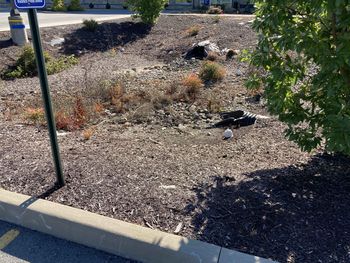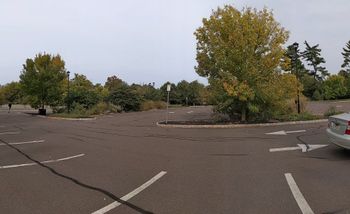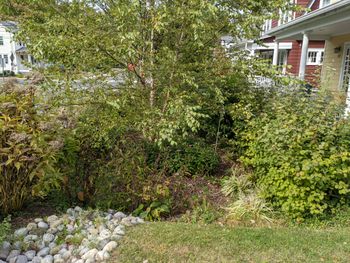Rain garden: Difference between revisions
imported>Roger A. Lohmann (Add new first sentence/definition) |
mNo edit summary |
||
| (15 intermediate revisions by 2 users not shown) | |||
| Line 1: | Line 1: | ||
{{subpages}} | {{subpages}} | ||
{{Image|rain.garden.jpg|right| | {{seealso|Rain garden/Gallery}} | ||
'''A Rain garden''' is a planned, eco-friendly, natural space strategically placed within otherwise environmentally unfriendly urban spaces. Rain gardens function like native forests to help slow, soak up, and filter polluted urban runoff from downspouts, driveways, parking lots and other hard surfaces. Typically, a rain garden is a designed shallow recessed surface containing flowers, small trees, shrubs and grasses | {{Image|rain.garden.jpg|right|350px|West Virginia University grounds}} | ||
'''A Rain garden''' is a planned, eco-friendly, natural space strategically placed within otherwise environmentally unfriendly urban spaces. One source says "a rain garden is basically a plant pond" containing plants with deep roots. <ref>https://www.familyhandyman.com/project/how-to-build-a-rain-garden-in-your-yard/</ref>. Rain gardens function like native forests to help slow, soak up, and filter polluted urban runoff from downspouts, driveways, parking lots and other hard surfaces. Typically, a rain garden is a designed shallow recessed surface containing flowers, small trees, shrubs and grasses selected to tolerate wet winters and dry summers. Also known as [[bioretention ponds]], rain gardens are typically designed by [[landscape architect]]s or urban designers to reduce the rate of flow of runoff from heavy rains or snow melt and filter the pollutant load originating from road treatment chemicals and other sources. | |||
Rain gardens are beneficial to local environments in many different ways. Stormwater flowing off impervious surfaces in urban areas is often warmer than natural groundwater and may even contribute to overheating in some aquatic ecosystems as well as the reduction of dissolved oxygen (DO). Stormwater runoff flowing off hard or compacted surfaces during rain is also a source of a wide variety of pollutants pollutants including many different volatile organic compounds, pesticides, herbicides, hydrocarbons and trace metals | Rain gardens are beneficial to local environments in many different ways. Stormwater flowing off impervious surfaces in urban areas is often warmer than natural groundwater and may even contribute to overheating in some aquatic ecosystems as well as the reduction of dissolved oxygen (DO). Stormwater runoff flowing off hard or compacted surfaces during rain is also a source of a wide variety of pollutants pollutants including many different volatile organic compounds, pesticides, herbicides, hydrocarbons and trace metals | ||
| Line 8: | Line 9: | ||
Open downhill lots, small green spaces in alleys and parking lots, barriers between rows for parked cars in parking lots, traffic islands, low spots outside large buildings (especially those on the low sides), existing creek beds and drainage ditches, and an almost infinite variety of additional urban spaces are all potential rain garden sites. | Open downhill lots, small green spaces in alleys and parking lots, barriers between rows for parked cars in parking lots, traffic islands, low spots outside large buildings (especially those on the low sides), existing creek beds and drainage ditches, and an almost infinite variety of additional urban spaces are all potential rain garden sites. | ||
{{Image|Raingarden ChoirCollege Princeton 2020-1010.jpg|left|350px|Rain gardens in autumn occupying low ditches between parking strips in Princeton, NJ}} | |||
{{Image|Raingarden LindenSt Princeton 2020-1010.jpg|right|350px|Rain garden in autumn, occupying the sunken front yard of a small house near the bottom of a hill in Princeton, NJ}} | |||
=Rain Gardens In Dry Climates= | |||
Rain gardens are also applicable in dry climate urban areas that are also subject to periodic flash flooding like the [[Rio Grande]] and [[Pecos]] river valleys. In such cases, however, the deep rooted plantings in such gardens may be very different from those found in more moist climates. | |||
=Private and Public Gardens= | |||
Rain gardens are being adapted to both private locales, both businesses and households and to public settings as diverse as [[public park]]s, college and university campuses, hospitals and hundreds of other locations. Traffic islands in shopping center parking lots are a key location because of the huge masses of impermeable asphalt and roofing materials involved. | |||
==References== | |||
<references/>[[Category:Suggestion Bot Tag]] | |||
Latest revision as of 16:01, 9 October 2024
- See also: Rain garden/Gallery
A Rain garden is a planned, eco-friendly, natural space strategically placed within otherwise environmentally unfriendly urban spaces. One source says "a rain garden is basically a plant pond" containing plants with deep roots. [1]. Rain gardens function like native forests to help slow, soak up, and filter polluted urban runoff from downspouts, driveways, parking lots and other hard surfaces. Typically, a rain garden is a designed shallow recessed surface containing flowers, small trees, shrubs and grasses selected to tolerate wet winters and dry summers. Also known as bioretention ponds, rain gardens are typically designed by landscape architects or urban designers to reduce the rate of flow of runoff from heavy rains or snow melt and filter the pollutant load originating from road treatment chemicals and other sources.
Rain gardens are beneficial to local environments in many different ways. Stormwater flowing off impervious surfaces in urban areas is often warmer than natural groundwater and may even contribute to overheating in some aquatic ecosystems as well as the reduction of dissolved oxygen (DO). Stormwater runoff flowing off hard or compacted surfaces during rain is also a source of a wide variety of pollutants pollutants including many different volatile organic compounds, pesticides, herbicides, hydrocarbons and trace metals
Especially important in areas prone to flash flooding in creeks and rivers, rain gardens also provide first-stage and localized flood control near the source. They can also improve water quality by filtering runoff. They also encourage sustainability for wildlife and biodiversity and encourage diverse planting opportunities. Rain gardens also have the potential to create aesthetic landscaping sites, and potentially tie buildings and their surrounding environments together in environmentally advantageous ways. Altogether, they provide significant solutions to important environmental problems that affect many aspects of life.
Open downhill lots, small green spaces in alleys and parking lots, barriers between rows for parked cars in parking lots, traffic islands, low spots outside large buildings (especially those on the low sides), existing creek beds and drainage ditches, and an almost infinite variety of additional urban spaces are all potential rain garden sites.
Rain Gardens In Dry Climates
Rain gardens are also applicable in dry climate urban areas that are also subject to periodic flash flooding like the Rio Grande and Pecos river valleys. In such cases, however, the deep rooted plantings in such gardens may be very different from those found in more moist climates.
Private and Public Gardens
Rain gardens are being adapted to both private locales, both businesses and households and to public settings as diverse as public parks, college and university campuses, hospitals and hundreds of other locations. Traffic islands in shopping center parking lots are a key location because of the huge masses of impermeable asphalt and roofing materials involved.


